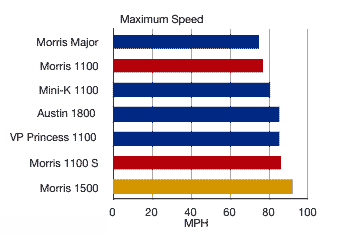Performance Comparisons
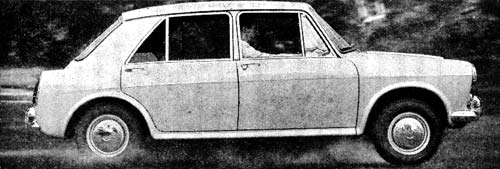
Much is made of the increases in engine size and power with each new model.
But how much difference really exists between the Morris 1100 and the 1100 S?
And how do they compare with their BMC stablemates?
Around town acceleration
The 0-40 MPH acceleration graph shows that the original 1100 had an edge over its more conventional predecessor, the Morris Major, making it a better bet in the suburban traffic light "Grand Prix".However, it also shows a similar improvement was gained by switching to the 1,275cc engine for the 1100 S.
The slower time for the Princess 1100 is not necessarily due to the weight of its luxury trimmings - it has twin carburettors to offset that. But like its British 1100 cousins, it has a higher final drive ratio of 4.13. When the Austrailan 1100 was fitted with this late in 1968, its acceleration mirrored that of the Princess.
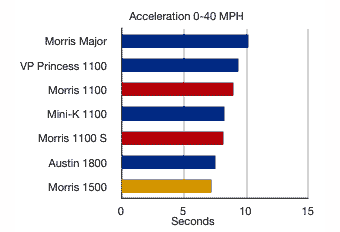
Open road acceleration
The 0-60 MPH acceleration graph shows just what a dramatic difference exists between the 1100 S and the original 1100 - nearly 7 seconds - and that the Morris 1500 (the Civilized Sports car) was 2 seconds faster again - a whopping 9 second improvement over the original 1100.Interestingly, the 1100 S shows greater improvement at faster speeds suggesting its overall gearing is biased towards relaxed high speed cruising rather than startling low speed acceleration. At the time of release of the 1100 S there was considerable debate over which final drive ratio to adopt.
The first 3,000 of the 1100 S received the high 3.76 ratio, but BMC changed to the lower ratio (4.13) used on the English 1,098cc cars, including the Princess 1100, which may have improved the 0-40 times.
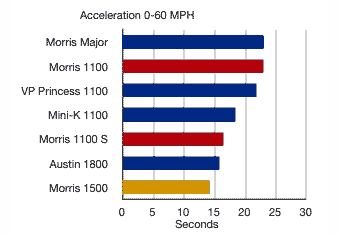
Flexibility
The 30-50 MPH acceleration graph gives an indication of the flexibility of each car's engine/gearing.A slow time indicates a need to change down to third gear to obtain satisfactory progress in this speed range, while a quick figure indicates potentially less gear changing.
The Vanden Plas Princess 1100 is higher geared overall than the Morris 1100 and it is only above 50 MPH that this comes to the fore. The graph shows that the 1100 S has a significant advantage over the ordinary 1100 - indeed it matches the Austin 1800.
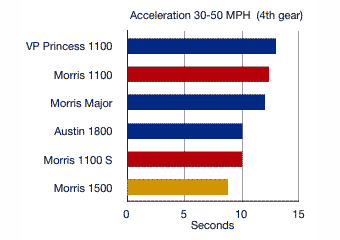
Maximum Speed
Again, the 1100 S easily out paces the ordinary 1100 (and just pips the Austin 1800) but the surprise is perhaps the Vanden Plas.
Although its acceleration times are mostly behind the Morris 1100, its higher gearing clearly provides more effortless (and quieter) cruising with a maximum speed of 85 MPH, 10% higher and just shy of the bigger engined 1100 S at 86.
However, the Australian Morris 1100 had the lowest ratio of 4.26 - before it received the 4.13 ratio and this boosted its top speed by 4MPH (at the expense of acceleration) to 80MPH.
So, in the final analysis, it seems that putting a 1,275cc engine into the 1100 was one of BMC's better ideas!
